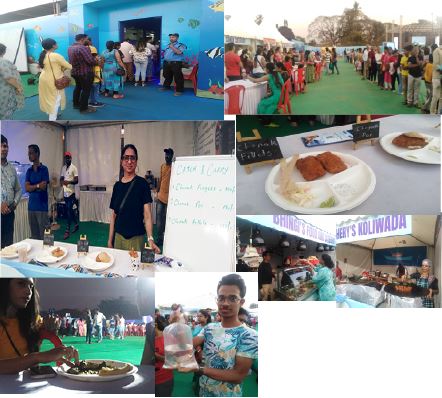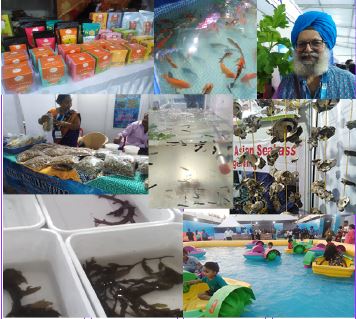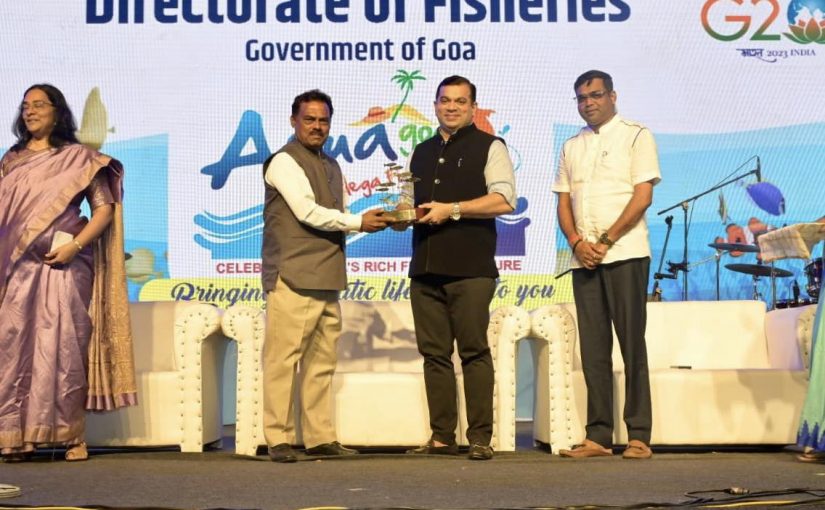The 6th edition of Aqua Goa Mega Fish Festival, organised by Directorate of Fisheries in collabration with the government of Goa, gets better every year! Enjoying the marine display with Fisheries Minister Nilkant Halarnkar is Tourism Minister Rohan Khaunte and Jit Arolkar (MLA, Mandrem).
WE are a never-ending country of festivals good, bad and ugly! In Goa too festivals roll-call is excessive and all on public account (by a heavily indebted government both at Centre and State-level and now the post-earthquake stories of tragedy and rescue stories in Turkey and Syria). But of all the Goan festivals the Aqua Goa Mega Fish Festival at the parade grounds of Panaji is absolutely my favourite.
Since I live in Panaji nearly I went out on two evening but the queue winding into the main aquariums exhibition almost wound out of the gates at the main Campal promenade road. I skipped the queue and instead wandered around at the well of colourful fish and the children’s boat pond and sea food stalls – feasted on fried sea bass or chonak fish finger fries served up at the Cash and Carry Live Goan Chonak stall…with a wee bit of cabbage coleslaw salad in eco-friendly paper cups. There is very little health consciousness in our foodie festivals!
Salt fish chonak fish fries are more flavorful but these fresh-water bred chonak fries were hot and crunchy and I preferred them to all the other spiced up fare being served up elsewhere. Why do we always go for fried fish! Like there is no such thing as baked fish, poaced fish, even air-fry fish…the refined oils have become a no no, unless of course one is consuming them rarely and for old times sake like I am doing these days or pretending that I am. Anyway, the 100% deep fried chonak finger fries were irresistible and two cups of them pretty much made for an early dinner for me both evenings.
A Shabana at the Catch & Carry stall confided nowadays only two per cent of the fish we eat in Goa is sea fish, “Most of the fish we eat is fresh-water harvested fish!” That’s how successful fresh water breeding and harvesting fish businesses have become; they do only fresh chonak or sea bass/barramundi from the sound of it. Chonak meat has presumably replaced the imported basa fish from Vietnam which turned up invariably and ubiquitously on restaurant menus for some time – pretty bland basa fish, pink perch! Goan sea water harvests of fish are being exported to the Middle East and elsewhere for big money or so I was told. After the formalin-infested fish scam of fish coming into Goa from other far-flung states in India, Goans at least don’t want to eat “outside fish.” They prefer to patronize tuna canned fish…the Lakshadweep tuna is very good and make for great sandwiches.

It was an eye-opening splendid exhibition offering fascinating insight into the life and times of marine and fresh water life with a line-up of aquariums here, there and everywhere …people flocking in with excited children in tow wanting to buy pet fish in glass bowls! Women put their hands in a deep aquarium trying to catch a slippery fat fish be it Asian seabass or grouper or pompano or redsnapper, pearlspot, cobia…there was also a stall with the “pedicure fish” – put your feet into this basin and the little fish swarm around nibbling away at calluses (fungal growth?) till your feet feel like they’ve pretty much got a pedicure in a beauty parlour!
Aquaculture is real going places given the fact that Goans and our coastal communities are dedicated to seafood eating. Mostly fried and spiced up seafood eating though! No, not healthy at all and I will be a killjoy and tell you here that maniacal consumption of seafood including shellfish is a contributing cause for pancreatic cancer so prevalent in Goa…along with liquor consumption. Cancer comes with a package of other rotten lifestyle habits too of course and this is not to say quit eating fish. By all means feast on fish but make sure it is comes from non-polluted waters be it marine waters or river waters or pond waters or aquarium waters.
QUITE few folk are actually into breeding their own choice of fish in tanks in their home gardens, backyards, balconies – like my dear friends Neeno and Peter Singh are doing, using simple eco-friendly and organic techniques of recycling, harvesting some choice fish too. The fish breeding waste water is recycled into their garden patches and pot and they get some amazing strawberries, lettuce and veggies for their home consumption. Neeno tells me their neighbours at Dona Paula on the outskirts of Panaji think they are a mad couple, instead of leading a laid-back retired life “we are running around working in our little garden and terrace and just about everywhere we can put up fish tanks or garden veggies! But this is what is keeping us happy!”
Peter also runs online classes for those who wish to learn how to do their own harvesting of garden produce and fish. If is amazing how one may set up one own home plant to sow and harvest veggies and fish, and be free from suspicious and expensive market purchases. I dare say Neeno doesn’t go do too much market shopping and Peter Singh has a brilliant fund of information which he shares generously. Truly to take inspiration from a true urban farmer, one to emulate in our stressed out times when inflation is spiralling away merrily.
There is so much to urban farming today. Go eat some of the strawberries harvested by Peter and Neeno…truly to live for strawberries (because the commercial lots of strawberries and even grapes come infested with chemicals residues…compare the flavour of grapes with chemically inspired thick skins and naturally inspired thin skins which melt in the mouth!

TO stay with fish entrepreneurs there is pioneering Deepak Gadre’s Gadre Marine Export’s folk growing from strength to strength, with their “so-fish-ticated” snacks of ready to cook and feast on crab sticks, imitation crab claw Amritsari, fish mince pop-ups, lobster bites, breaded fish fingers, tilapia fish patty, shrimp triangles, masala mackerel, seer fish steak and new additions of prawn curry and biryani, fish seekh kebab, masala mackerel, jumbo/large/small prawns.
I stopped to enquire about the packets of edamame or tender soybeans harvested and refrigerated for export from Japan…you have to remove them from the green pods before eating the tender soybeans, said to be all things good – naturally gluten-free, low in calories, no cholesterol, instead you get iron, calcium, complete protein values replete with essential amino acids, omega-3 and antioxidants. The 500 g pack was about Rs400 and I didn’t buy it finding it too expensive, these are hard times, okay.
But I wonder why nobody cultivates soybeans in India, or are farmers doing it? The oriental soybean culture just can’t replace India’s dairy milk culture – never mind that we do not get natural organic fresh dairy milk anymore in old-fashioned amber bottles as of old! In any case it’s inadvisable to freak out on dairy products/produce, bovine milk only contributes towards respiratory ill health. Soybean produce in comparison is a far healthier alternative to dairy and meat products out in the South-East Asian wet markets…early morning the wet markets are a joy to behold. Buy fresh soy beans, buy crunchy soybean sprouts, soy cheeses or tofu soft and firm, tofu nuggets.
I am forever in love with the Chinese street vendors who retail freshly made soybean milk hot and cold, as also silky white soybean curd served up hot or warm topped with dark brown palm jaggery syrup. Eating out holidays in the south-east Asian countries are worth it just for the soybean vegetarian cuisines amongst other things! Soybean produce offers superlative food values in comparison to dairy products. You want to get organically grown soybean produce though and not the genetically modified soybean produce of USA.
Ancient and even the modern Chinese reap good health on fresh soybean foods even in their senior years. There are all kinds of proven reasons why one should consume more soybean produce beginning with soybean milk and tofu…go for it. Make scrambled tofu instead of egg scramble for breakfast tomorrow and garnish it with lots of spring onion greens!
A REMINDER brief on the values of eating fish here. You must know fish is on top of the list of super health food for humans, it is what makes for good eyes and good hair and good brains! Traditional food wisdom also confirms this. Go check out fish-loving Bengalis and other fish-loving communities in India. Fish is full of omega-3 fatty acids, rich in vitamins D and B2 (riboflavin), plus minerals calcium, phosphorus, iodine, zinc, magnesium, potassium, etc. The American Heart Association recommends fish eating at least twice a week for a healthy heart or cardiovascular system…eat tuna, salmon, oysters, sardines, rainbow trout, freshwater coho salmon.
The Indian surmai or seer is rich in lean protein, it is the omega fatty-3 acids which protect and improve eyesight, fresh tuna is said to have high protein values, generally speaking eating fish regularly protects delicate blood vessels in the brain from subtle damage that can lead to cognitive impairment, dementia, or stroke. Not for nothing is fish considered brain food (along with beans). The idea is to eat less saturated fat and more unsaturated fat. Oh yes, fish eating is better than chicken, mutton or beef eating.
But the one thing to beware is mercury and PCB build-up in the fish we eat…marginal mercury is already there in sea greens like algea which marine life feeds on and we know pretty much that our seas and oceans are turning into deadly water bodies, courtesy our poisonous industrial and unsustainable civilisation of greedy humans! Contaminated seafood can definitely damage the brain and the nervous system. Mercury is said to be now endemic in sea food and vegetation.
HENCE, the current focus on rearing or breeding fish in fresh water systems – we don’t know if cultivated fish is as nutritious as sea water or river water fish from organic live waters though! Or do we? Heart patients I know stay alive on supplements of krill fish extracts, very expensive. This is just to say by all means eat more fish but make sure it comes from honest waters be it in freshwater harvesting farms or clean sea waters. I must confess I have a soft corner for chonak, modso and trout caught fresh and cooked on the spot and consumed – like folk do on trekking and hiking holiday in the wilds which still exist in India and abroad.
But stay away from fried fish, if you can…do more baked and poached and oh well, lightly olive oil or mustard-oil grilled fish, my friend Mita Sen at Salt Lake city in Calcutta long ago introduced me to “rohu doi machh” a long, long time ago and I cannot think of a better way to cook fish! Very flavorful recipe with the use of buttermilk or dairy curd. Actually, very little oil needs to be used if we make a tangy onion-tomato gravy in which one may simply poach cook fish fillet or fingers with closed cover.
I do think Bengali ways of cooking fish are more health-conscious than Goan or Kerala or Andhra or Bihari ways! I keep looking for decent “fish cakes” or “fish cutlets” in the supermarket places of Panaji …without much luck. These make for a great evening meal tucked in a bowl of salad greens with lots of lemon juice squeezed on! I’m thinking of non-spiced up fish cakes, okay, and not the usual ones overloaded with potato filling with miniscule mackerel!
I LOOKED for the algea supplement spirulina at the mega seafood expo in Panaji last weekend …but couldn’t find it. There were several stalls doing nutritious feeds for fish…if you’re breeding and harvesting your own fish you have to feed them on nutrient rich feeds naturally! We are in search of organic earth and water for nutritious food to stay alive and kicking regardless of whether we are vegetarians or non-vegetarians. And less mindless processed industrial foods.
Every day I listen to the iconic John Robbins with son Ocean Robbins telling me to switch over to a plant diet, eat only plant food. Listen to their Food Revolution Network talks over Facebook these days and you will be convinced that’s the only way to rescue ourselves from our current epidemic of degenerative ill-health and the depressions which come along with all that – all the time we’re fighting to manage our body with the diminishing returns of costly medicines or the drugs of Allopathy!
Think about all this and don’t just think. Be the change you want to see in the world first.
